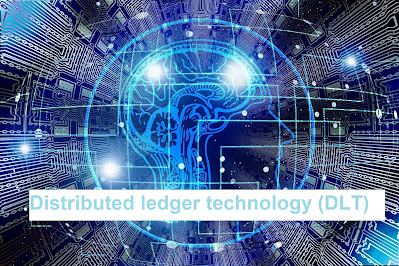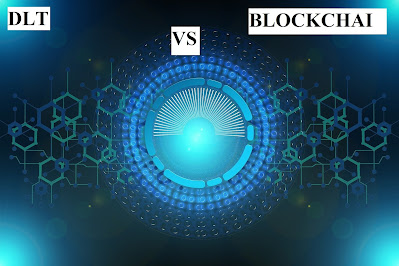What is Distributed ledger technology (DLT) and Blockchain?
How they are difference from each other?
Difference companies used DLT and Blockchain?
Distributed ledger technology (DLT)
Distributed ledger technology is a decentralized distributed
computerized framework for keep exchanges between parties in different spots
simultaneously. DLT sends cryptography and agreement components to permit
members to share an unchanging copy of a similar record. It disposes of the
requirement for a concentrated store of information and gets rid of the
prerequisite for a focal power to complete managerial capabilities, as is
important with conventional data sets. Disseminated record innovation (DLT) is a computerized
framework for keep the exchange of resources wherein the exchanges and their
subtleties are kept in numerous spots simultaneously. Not at all like
conventional data sets, circulated records have no focal information store or
organization usefulness.
Blockchain
A subset of
DLT, is a public permissionless record open to every single intrigued member,
who may likewise stay unknown to each other. All exchange information is
imparted to and annexed by all members with agreement accomplished at the
record level. The bitcoin blockchain is an illustration of a public
permissionless disseminated record.
Blockchain
innovation empowers everybody associated with an exchange to be aware with
sureness what occurred, when it worked out, and affirm different gatherings are
seeing exactly the same thing without the requirement for a mediator giving
confirmation, and without a need to accommodate information subsequently.
The two terms
"blockchain" and "DLT" are frequently utilized conversely
and to comprehend blockchain, it's critical to figure out Dispersed Record
Innovation (DLT) — the system that supports it.
In its least
complex structure, a dispersed record is a data set held and refreshed freely
by every member (or hub) in an enormous organization. The conveyance is
exceptional: records are not imparted to different hubs by a focal power,
however are rather freely built and held by each hub. That is, each and every
hub on the organization processes each exchange, arriving at its own decisions
and afterward deciding on those ends to cause specific the greater part to
concur with the ends.
When there
is this agreement, the disseminated record has been refreshed, and all hubs
keep up with their own indistinguishable duplicate of the record. This design
takes into consideration another finesse as an arrangement of record that goes
past being a straightforward information base.
Difference between Blockchain and DLT
Difference between DLT and BLOCKCHAIN....Are
blockchain and dispersed record innovation the equivalent? No. This is a
typical misguided judgment that many individuals have. In this article, we
investigate what blockchain is and it's disparities and similitudes to
appropriated record innovation.
We are living in a computerized time of short clips and trendy expressions. An age where even complex mechanical arrangements are diminished to five words or less. Subsequently, we are seeing an ascent in tricky organizations endeavoring to piggyback the supposed crypto blast. Some are in any event, doing this by rebranding with 'blockchain' in their name.
Typically, utilizing popular expressions, for example, blockchain innovation to draw in venture will just convey momentary additions. Amusingly such activities are liable for the marking issues of this tech. Prompting one reason why many are careful about blockchain. In the mean time, arising patterns recommend that circulated record is offering some benefit and unmistakable outcomes without the promotion.
Blockchain has raised a ruckus around town on a practically regular routine close by the ascent of Bitcoin and other digital forms of money. Be that as it may, disseminated records have not gotten a similar degree of concentration. Words like dispersed record innovation and blockchain in a similar sentence frequently leave individuals with additional inquiries than responds to. This is before you in any event, carry Bitcoin in with the general mish-mash to additional mess everything up.
Individuals frequently consider blockchain innovation and disseminated record innovation as the equivalent. It's not difficult to see the reason why many would think thusly. Presently the time has come to scratch underneath the surface and see reality behind the trendy expressions. Albeit these terms have become weaved throughout recent years, it is fundamental to recognize the two from each other.
However, DLT additionally incorporates permissioned private records which are more qualified to utilizes where protection of conditional information is significant, as is much of the time the case with monetary administrations applications. Members in permissioned private records are all around known to one another and the arrangement of clients who reserve the option to approve exchanges is confined. Data about exchanges is just imparted to those gatherings to an exchange and agreement is accomplished by adding computerized marks to a shrewd agreement, not by counseling a larger part of clients of the record.
Five companies using Distributed Ledger Technology
Disseminated Record Innovation has proactively caused disturbances across a few ventures because of the security and effectiveness benefits a blockchain gives
Tradle
Know Your Client, Know Your Client, or basically KYC is the
cycle a guarantor should go through to confirm the personality of a client,
that they are so reasonable to work with and whether they represent a
misrepresentation risk.
ChainThat
A dispersed record has a few applications in the realm of
protection, and a few organizations are crossing more than one of them.
Lemonade
Lemonade will be the name generally natural to those
perusing this rundown, as the insurtech surprised the business when it turned
the first idea of protection on its head.
Dissimilar to other savvy gets that depend on a parametric event like a super climate occasion to set off — Lemonade depends on simulated intelligence based calculations to lay out guarantee authenticity and the conduct financial matters of clients not having any desire to remove cash from their picked cause to deter them from overstating the reason for misfortune
Black
A less popular organization soon to enter the insurtech
space with a blockchain-based item is Dark.
Etherisc
Brilliant agreements work most productively when they're
attached to an unquestionable wellspring of data, for example, a weather
conditions administration or flight plan.






